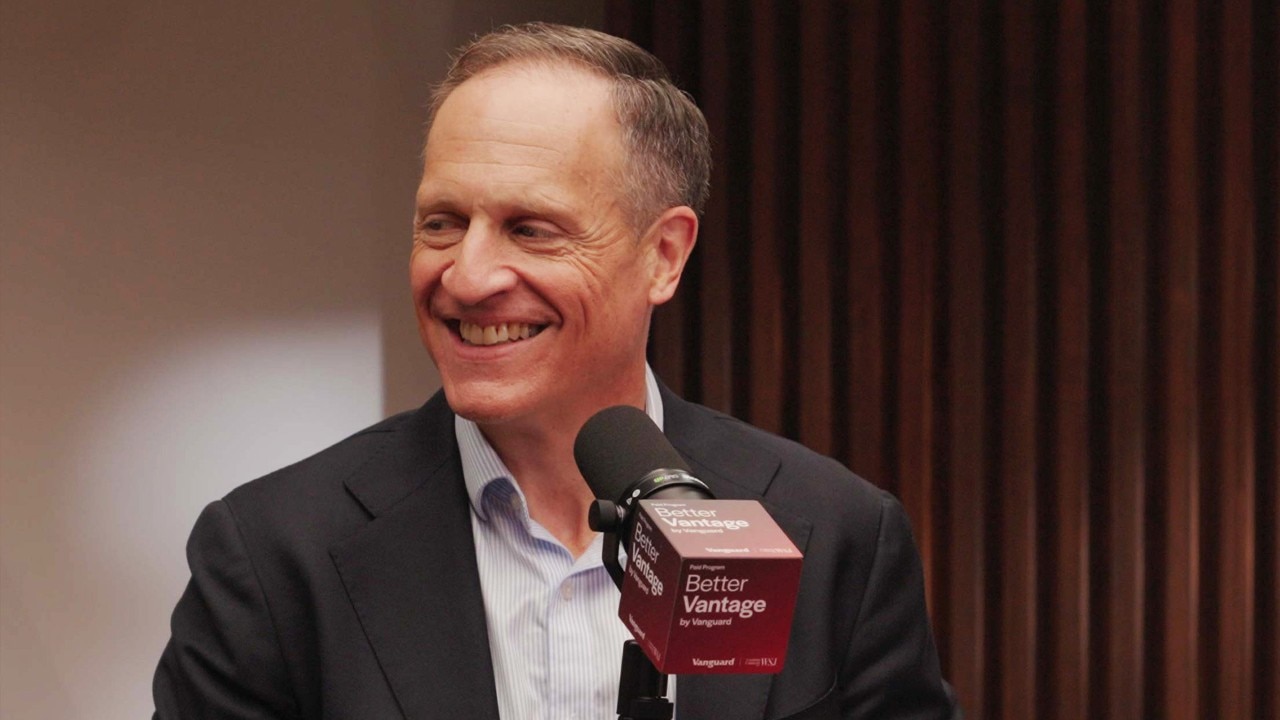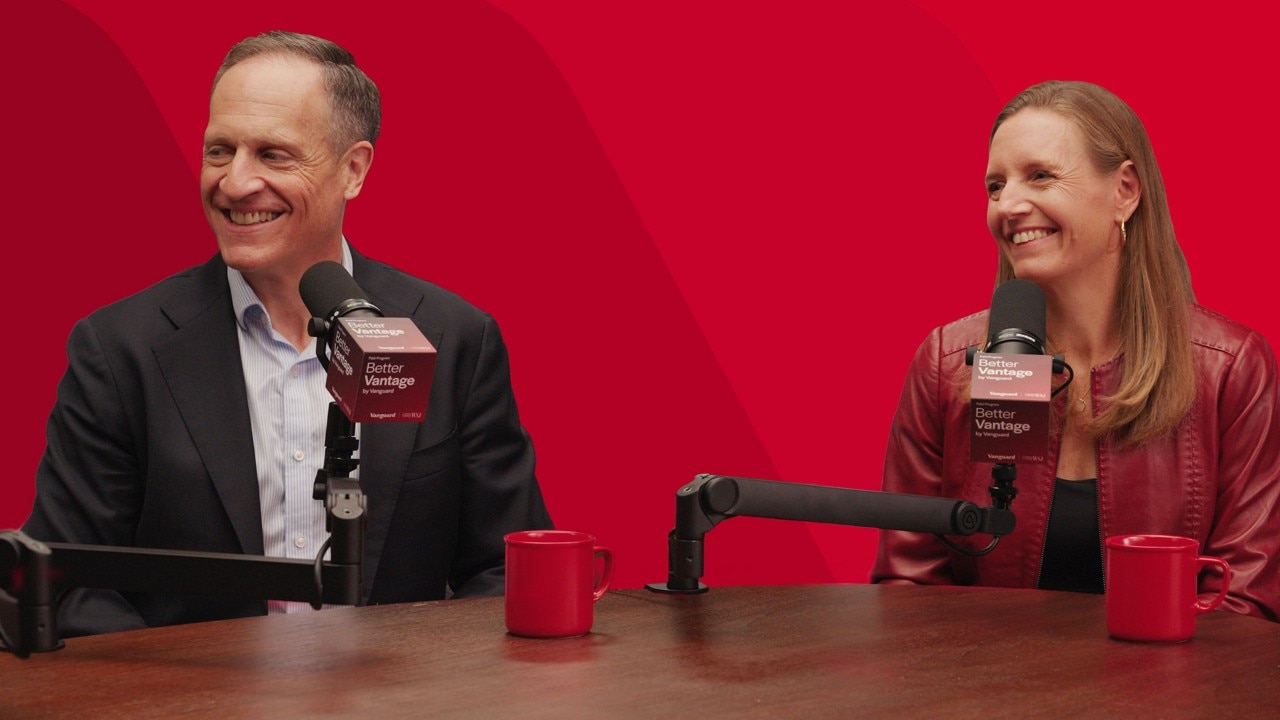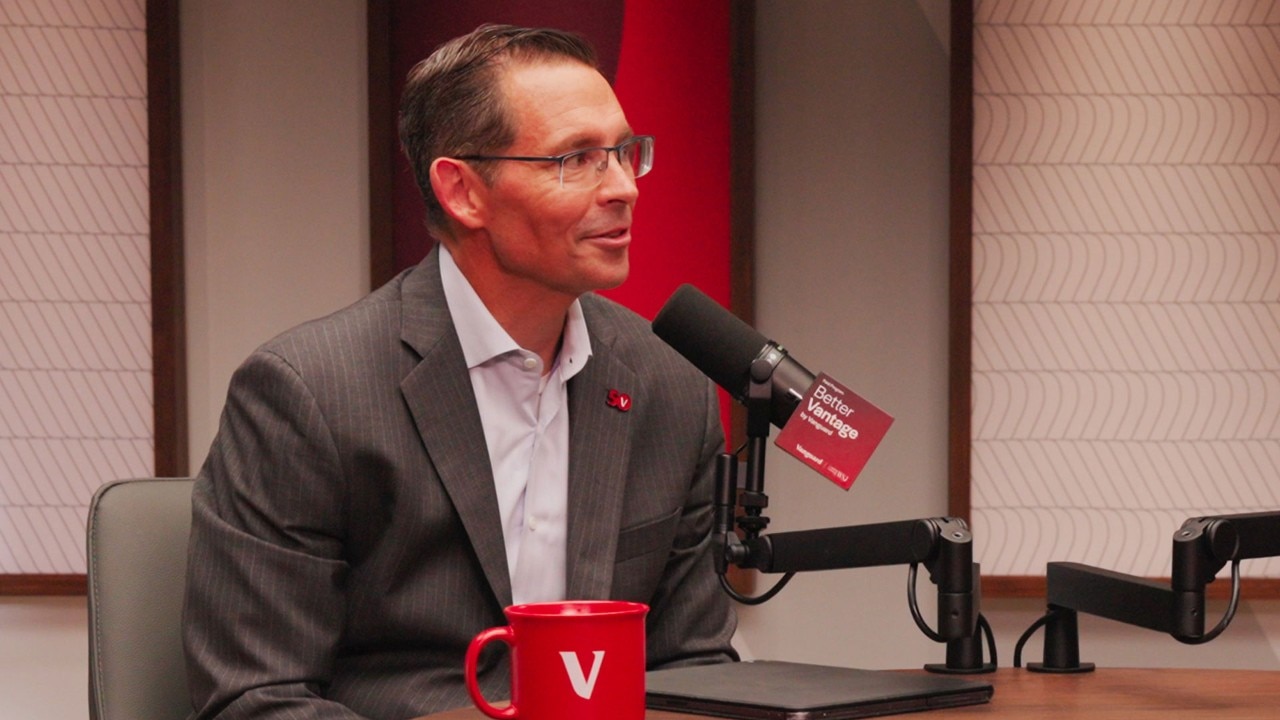Better Vantage podcast
A new era for fixed income
September 17, 2025
Read the transcript
Christine Kashkari: Welcome to Season 1 of Better Vantage by Vanguard, a podcast series hosted by Custom Content from WSJ and Vanguard. In this series, we’ll be discussing the most pressing topics driving conversations among financial advisors and investors today. In each episode, we’ll be sharing market insights and strategies that can lead to greater conviction when investing.
I'm your host, Christine Kashkari, editorial director for WSJ Custom Programming. Joining me today is my cohost in this series, Joe Davis, Vanguard’s global chief economist. And our special guest for today is Sara Devereux, Vanguard’s global head of fixed income.
Today we are talking about this new era of fixed income and how investors might be positioning themselves for this resurgent asset class in the coming decade. Joe, Sara, welcome.
Sara Devereux: Thank you.
Joe Davis: Thanks.
Sara: It’s great to be here.
Christine: Sara, let’s start with you. We’ve just emerged from a decade where fixed income played a marginal role in returns for long-term portfolios. But now Vanguard is saying that bonds are back. What do you mean by that, and how has fixed income changed?
Sara: I would say “bonds are back” is really just a call to action for investors to revisit their allocation to fixed income because we do believe we are in a new era for fixed income where bonds are going to offer more value. And if you look back, there was an extended period of time where bonds had very little returns. The Fed held the policy rate at the zero lower bound for the better part of a decade after the GFC, and bonds just really weren’t attractive in that environment.
Fortunately, that era is over. We are entering a new era where we think that value has returned. And I’d really characterize that value across three pillars. First is just attractive valuations. Second is that income engine, it’s really powerful. And third is that balance and diversification that you get by having fixed income in the portfolio.
Christine: Joe, I know your team works on long-term expectations for global financial markets. What does your most recent work suggest about the coming decade?
Joe: Yes, it’s newer research, but I’m really proud. We spent a lot of time the past two or three years, Christine, saying, “When were interest rates going to rise and get over that rate of inflation?” We continue to believe that this is a more permanent environment. Yes, we’re going to have ups and downs with the Federal Reserve and other central banks in terms of managing monetary policy.
But the fact is it’s very likely for the next three, five to seven years, that real rates, which means interest rates, or the yield on a bond fund net of inflation over the past three or five trailing years, will be positive. Sara’s right on point and bonds are back because they are achieving real returns. You really had to just lean on the equity market for the past two decades.
So, in my mind, this environment, although it may seem newer, is arguably one of the best capital market developments, financial market developments, for investors over the past 10 or 15 years. Equities will continue to add value over long stretches of time, but particularly in the U.S., there’s pockets of overvaluation.
And so when you look at that, just be attentive to the risk. And per unit of risk, fixed income is looking really attractive. And again, that’s different from where we have been for roughly 20 years, right? And so that’s where our outlook continues to point.
Sara: We do believe that bonds offer diversification versus equities. They tend to rally when equities are selling off in a flight-to-quality bid. Doesn’t hold every minute of every day, but we do think it holds over the long term. In fact, Joe, you and your team have done a lot of work on that. They’ve shown, they’ve proved, that over the last 30 years, bonds have been an effective diversifier to equities when needed most. So we think that’s a really important quality when building a portfolio.
I would just maybe at the highest level think of it like insurance. For a long time, to get that insurance in your portfolio you had to sacrifice return, right? Usually, you have to pay for that protection, but now you can get an attractive yield and get that protection at the same time.
Christine: Joe, let’s talk about the environment. The market has been pretty jittery since the start of the year with tariffs and fiscal deficits. And bonds—normally a safe place to go—may also be now a source of risk for investors that intuitively would avoid bonds because of rising deficits. I think you’ve said that this could backfire. How so?
Joe: I hear some media reports of a U.S. fiscal crisis, our reserve currency status—our group has actually done the research saying that deficits do matter and interest rates would be higher in this environment. I’m also saying that those sound like alarmist statements. The odds of that over the next several years are low. I’m not saying they’re zero, but they’re lower than I think some headline reports suggest.
And so, what does that mean? That means as an investor, if you’re listening, I still expect some flight-to-quality. If we have severe market volatility, I can rest assured that the equity market would probably be losing value more quickly than fixed income and high-quality fixed income.
Christine: Sara, how are those concerns reflected in the market?
Sara: So, as Joe said, the sustainability of debt is fragile. It is concerning looking forward, and I mean it’s possible that we can grow our way out of it with AI, for example, but it is concerning. But in terms of the market, more U.S. debt means more U.S. Treasuries, right? The Treasury market’s grown by about 10 trillion since 2019, which is a substantial amount. Fortunately, the Treasury market is a deep, liquid, well-sponsored market, but we have seen volatility in what I will refer to as the term premium.
Now, what is the term premium? The term premium is a risk premium. Meaning, when there’s more risk, investors will demand to be paid more for the risks they’re taking on. It’s really that simple. What does that mean? That means the marginal buyers, other parts of the market, asset managers, hedge funds, pensions, right? Entities that are more price sensitive.
So that means that not only are there more bonds in the market, but that price action could be more volatile because those buyers are more price sensitive. So that’s sort of what is driving that term premium higher. We’re kind of at that median point of where the term premium has been over the last few decades, which means the price action from here can be more symmetric. It could go higher if fiscal deficit concerns spike, but it could also go lower or investors can just harvest that risk premium in the form of extra return.
Christine: But, Sara, let’s talk about some more nervousness in the markets, where investors still remember fairly well what happened in 2022. That was just three years ago when bonds hit a historic 100-year low. And as a result, they’re now holding on to an outsize allocation of cash.
Sara: Yes.
Christine: What do you say to them now?
Sara: Yeah. So, look, 2022 was a really tough year for all asset classes. I think all major asset classes had negative performance that year. In any case, it was a high inflation environment. I would also say there are several differences today versus then.
First of all, the pain of that year really set the bond market up for future success. One of the primary differences now is, as we talked about earlier, we’re in that new era, right? Yields are much more attractive. You’ve got that income, that power of income in the portfolio, and the diversification benefits. Those things are back. So that’s great, but also we have an upward sloping yield curve.
Joe: There’s always economic risk on the horizon, but from a fixed income perspective, there’s a greater cushion. It’s Sara’s bond math. I have to keep redoing that math to remind myself, but there is economic assessment risk. But I think—we talk internally—at least for the next several months, they’re more symmetric as we look out, right, Sara? We talk about that, they’re becoming a little bit more balanced.
So I’m saying, yeah, there is the risk of the downside, but we’re starting to contemplate 2026. We’ll have to still see, right, Sara?
Christine: For many investors, experienced investors, saying that equities would underperform fixed income is almost unthinkable. So what should investors be doing from a portfolio construction standpoint to prepare for a scenario that you’ve laid out where fixed income could outperform equities in the next 10 years?
Joe: That sounds fairly bold of a statement, right? But I’m not going to back away from it, Christine. It’s just around risk assessment. I’m hard pressed to say we have financial bubbles in part of the tech sector. It’s just, the fact is that, even with AI expectations of significant technology growth, you could still make the case—and we would make the case—that parts of the U.S. equity market in particular are somewhat overvalued. That just means the cushion of future returns over, say, fixed income is narrower.
Again, we have used the phrase 40/60 relative to a 60/40 benchmark, just to underscore the relative opportunities going forward, right? It doesn’t mean we’re in a financial bubble in the equity market and you sell your equities. But what it’s trying to underscore, I hope, is that the opportunities over the next several years very likely are different from what have been the realized, really amazing returns of the U.S. market, stock market in particular—U.S. exceptionalism, some call it—tech in particular. Mag 7 just seem to be in their own universe.
But again, as we said, fixed income in and of itself have higher interest rates and are above the rate of inflation, generally speaking. And you have other parts outside the U.S. and the equity market that could benefit from even some of these technology trends that have way lower multiples relative to the U.S.
So it’s from a risk management perspective where we come out from this, from the 40/60, we’re trying to show investors this is where some of the opportunities are from our data-driven framework.
Christine: Sara, let’s talk about those opportunities.
Sara: Overall, we’re really positive on fixed income as an asset class for the reason Joe cites and the other reasons we were talking about earlier. And we do think there’s room for both index and active in an investor’s portfolio.
So maybe I’ll take a sidebar on active. You know, we think back to Jack Bogle, and a lot of people associate index with Jack Bogle, but he was really about low cost. It just happens that when he was talking about low cost, it was synonymous with index, because you couldn’t do active at a low cost back then.
But now we have scale, we have skill, we have technology, you know, phenomenal teams. So we can actually deliver institutional-quality active at a low cost. I would point out though that we do believe that the opportunity in active fixed income is very strong. And I’ll contrast it to equities. In fixed income, in the aggregate index, the global aggregate index, there are 30,000 CUSIPs. We have over a million CUSIPs in munis. That’s a big contrast to the S&P 500.
So there’s just a lot of opportunity. There are a lot of CUSIPs, a lot of sectors. We have a phenomenal credit research team that covers 6,000 issuers; each issues multiple CUSIPs. So that opportunity to do real security selection—what I would call really true alpha generation, going bond by bond, name by name, and picking out the winners and losers—there’s a real opportunity there. That’s my sort of advertisement for active in general.
But I think your question was really what are we doing right now?
Christine: Well, that’s how you’re doing it, and now what are you doing?
Sara: Right now in our portfolios, we do like U.S. rates. We are marginally overweight in that middle part of the curve as a diversifier to the overweights we have in credit. We think there’s a tremendous opportunity in international rates markets. You know, there’s a lot of divergence in the macroeconomic regimes there. So we’re able to do relative value trading. There’s a lot of opportunity in relative value in international rates.
Also in what I would call the rate space—agency mortgages. We do carry an overweight there. And moving on to credit, we are overweight in credit, but we’re not full on, risk on, in credit because of where we are in the cycle and risks are elevated, and also valuations are relatively tight. We are more neutral on riskier asset classes like high yield and EM. Those are the areas where we’re really going to lean into that security selection.
Joe: Sara, how does your team stay disciplined when there’s powerful momentum in the marketplace?
Sara: I would say, you know, we have a differentiated approach to active, which we call our active edge. It’s grounded in the firm’s mission, first and foremost. It’s also embodied by, you know, our super-talented investing team and that collaborative culture, which helps get all the best trade ideas in all of the portfolios. And third, it’s just wrapped in that sophisticated process with disciplined risk management. That’s what you’re getting at. We really do believe that discipline delivers. We focus on consistent results over the long term and the proof is in the pudding: 90% of our active funds have beat the peer group average on a 10-year trail.
Joe: Do you prepare to underperform for a little bit?
Sara: I think what you’re hitting on is that we don’t change performance.
Joe: Yeah, right.
Sara: And we don’t have to, right? Some of the high-fee managers, as spreads get tighter and tighter and valuations get worse and worse, they take on more and more risk and they lever up just to hit that fee bogey. So as valuations get worse, we scale back, we get some dry powder, and then we can deploy that later when valuations are right. And what tends to happen is those high-fee managers who are fully risk on, in that moment when spreads correct, they get tapped out and they sell at the worst time in the market. And we’re there with our dry powder.
Christine: So what would be the top three things that you want our listeners to come away with?
Joe: One is that bonds are back. This is not new in the sense of, you know, looking forward, this is not going to be temporary. And I think that’s a positive thing. I think secondly is, you can think about bonds as a core holding. And then I think it’s, you know, this is coming from Vanguard, it’s active and passive. I think the whole debate, it really always should be centered around cost. I think that’s a good place to start.
Christine: Well, Sara, Joe, thank you so much. This has been great, and great talking to you both.
Christine: If you enjoyed this episode and found it helpful, subscribe and share.
In this episode of Better Vantage, Sara Devereux, global head of fixed income at Vanguard, discusses why fixed income is reemerging as a strong asset class after years of muted returns. The conversation highlights how higher yields, diversification benefits, and disciplined active management can reshape investor strategies for the decade ahead.
This series—created in collaboration with Custom Content from WSJ—dives into essential financial topics, offering expert perspectives on everything from tax planning and retirement income to building resilient portfolios.
Notes:
All investing is subject to risk.
Custom Content from WSJ is a unit of The Wall Street Journal Advertising Department. The Wall Street Journal news organization was not involved in the creation of this content.


